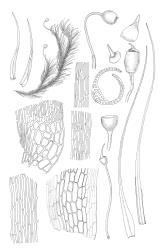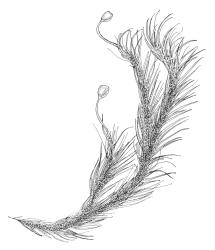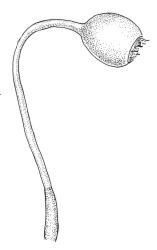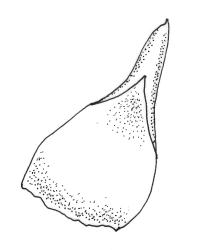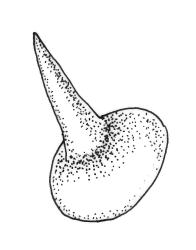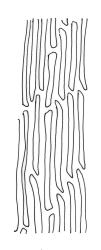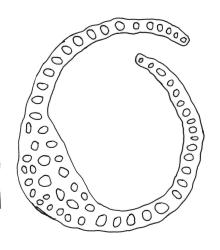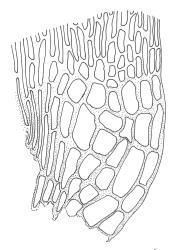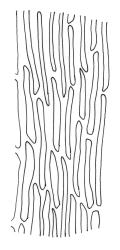- = Blindia acuta var. curviseta Hook.f. & Wilson, Bot. Antarct. Voy. III. (Fl. Tasman.) Part II, 172 (1859)
- = Blindia theriotii R.Br.bis, Trans. & Proc. New Zealand Inst. 35: 335 (1903)
Plants gold-green, or yellow-green above, light brown to olive-green in lower portions and in submerged forms, glossy. Stems c. 5–40 mm, flexuose, repeatedly branched by both innovation and forking, in cross-section with a central strand and thick-walled cortical cells. Leaves secund to ± falcate-secund (especially near stem apex), occasionally nearly straight when dry, similar when moist, not penicillate, narrowly ovate-lanceolate or with a weakly defined ± oblong base, evenly tapered or weakly shouldered with a rather stout subula which is ⅓–½ the total leaf length, narrowly acute or rarely ± rounded at apex, entire, crenulate, or denticulate at apex, subtubulose in lower half, (2.0–)3.0–5.0 mm; upper laminal cells (c. ⅓ above base) linear, weakly sinuose, strongly incrassate (the walls ± equal the lumina), variable in length, c. (21–)45–60 × 3–4 µm, expanded slightly at cell ends; lower laminal cells ± longer, but becoming very short and incrassate at extreme base; alar cells inflated, orange or hyaline, forming a very distinct group extending c. 4 cells up the leaf, and contiguous with a small number of subquadrate and incrassate cells that merge upwards with the laminal cells, separated from the costa by elongate, thick-walled, orange cells. Costa mostly 45–60 µm wide ⅓ above the leaf base, well-defined or occasionally ± fading at leaf base, stoutly excurrent and filling the subula, otherwise as per genus.
Dioicous. Perichaetia terminal but usually overtopped by innovations; perichaetial leaves from a broadly oblong and sheathing base, abruptly shouldered and narrowed to rather stout subula. Perigonia terminal, <1 mm, brown, usually overtopped by innovations, with inner perigonial bracts broadly ovate. Setae mostly 4–5 mm, flexuose-erect and twisted to the right when dry, strongly cygneous when moist; capsules broadly urceolate and weakly constricted below the mouth when dry, broadly obovoid to ± globose when moist, exserted, yellow-brown, 0.7–0.8 × 0.65–0.8 mm; exothecial cells irregular, strongly incrassate and weakly collenchymatous, several rows oblate and pigmented at rim; stomata few, superficial, and rather large; operculum rostrate from a weakly conic base, oblique, c. ½–⅔ the capsule in length, often systylious. Peristome well-developed but often broken in older capsules, the 16 teeth broadly lanceolate, neither perforate nor cribose, red, the outer surface nearly smooth; preperistome apparently absent. Calyptra as per genus. Spores 18–24 µm, smooth, green.
Bartlett & Vitt 1986, figs. 56–63, 145, 149; Seppelt 2004, fig. 99; Andreas 2013, fig. 5.
Blindia magellanica is in some respects similar to B. robusta and sterile plants can be best distinguished by the smaller stature and shorter leaves of the former. When capsules are present, the flexuose to cygneous setae of B. magellanica make confusion unlikely. There are no other species in the N.Z. flora with which confusion could occur.
NI: Gisborne (Lake Waikaremoana, Mt Maungapōhatu, Mt Te Wana), Taranaki (Mt Egmont), Wellington (Tararua Range); SI: Nelson, Marlborough (Mt Tapuaenuku), Canterbury, Westland (Ōtira, Franz Josef, Wilberg Range) Otago, Southland (Lake Manapōuri, Eyre Mountains, Mt Burns); Ch.
Austral. Tasmania*, Argentina*, Chile*. Reported by Bartlett & Vitt (1986) from South Africa, New Guinea, mainland Australia (Vic.), the Falklands, South Georgia, Hermite I., Staten I., Marion and Prince Edward Is, Kerguelen, and Tristan da Cunha, Colombia, Ecuador, and Brazil. According to Bartlett & Vitt (1986), B. magellanica "has the widest distribution of any of the southern hemisphere species of the genus". It is one of several "austral" mosses occurring in southern South America that also occur in high elevation ""páramos"" of the tropical Andes (Griffin et al. 1982).
On rock in the beds of swift streams, both submerged and emergent; often well developed in spray zones of waterfalls, seepages, irrigated/dripping outcrops, and on rocks at tarn and lake margins (as at Lake Waikaremoana and Lake Manapōuri). Occurring on a wide variety of rock types including granite, gneiss, schist, basalt, and greywacke. Blindia magellanica is the only member of the genus in N.Z. that sometimes occurs over limestone (as at Fenian Creek, Nelson L.D. and at Lake Orbell, Southland L.D.). Andreas (2013) recorded an occurrence on limestone in South America. Frequently associated species include Bryum laevigatum, Dicranella cardotii, Ochiobryum blandum, Philonotis tenuis, Rhacocarpus purpurascens, Schistidium apocarpum s.l., and Tridontium tasmanicum. Ranging from c. 600 (Lake Waikaremoana) to c. 1800 m elevation (Mt Egmont) on North I. and from 15 m (Waitātī, Otago L.D.) to c. 1800 m elevation (Mt Tapuaenuku) on South I.
Blindia magellanica has vegetative leaves that are ± evenly tapered from the base to the ill-defined subula whereas the perichaetial leaves are strongly differentiated and very distinctly shouldered. Bartlett & Vitt (1986) probably determined the subula:leaf base ratios for this species using perichaetial leaves.
Occasional specimens occur in which the leaf apices are distinctly rounded (e.g. G.O.K. Sainsbury 190 from Lake Waikaremoana, CHR 556425).
The collection history of this species in N.Z. is very confused. The species was treated by neither Wilson (1854) nor Hooker (1867), probably reflecting the few higher-elevation South I. collections available to those authors. Nor, apparently and surprisingly, is it represented in the Beckett herbarium. The scarcity of early N.Z. collections of this relatively widespread species in herbaria is perplexing. In 1874 S. Berggren collected B. magellanica from four South I. localities, all in the general vicinity of Arthur's Pass, but these collections were not reported for more than six decades (Dixon & Bartram 1937).
Dixon (1914, p. 60) discussed at length the confused taxonomic, nomenclatural, and collection history of this species in Tasmania, N.Z., and other parts of the southern hemisphere.
Dixon (1914, p. 61) mentioned R. Brown’s name B. theriotii from the Torlesse Range, Canterbury L.D., but neither he nor Bartlett & Vitt (1986) were able to locate type material of this name. According to Dixon "there can be no doubt from the description and figures that it belongs to B. magellanica".




